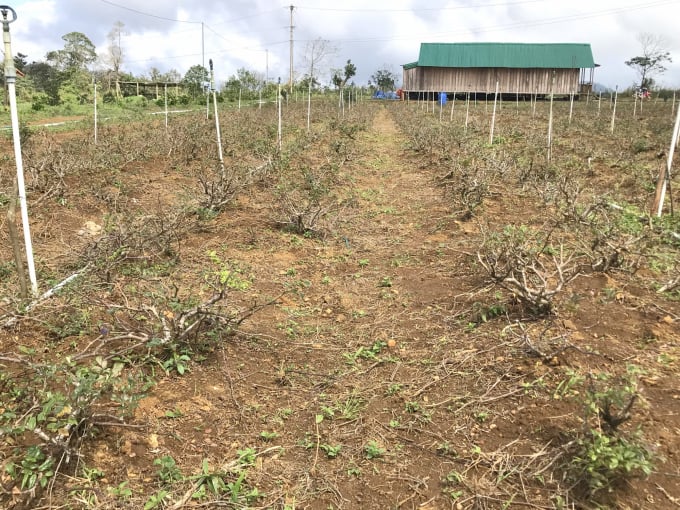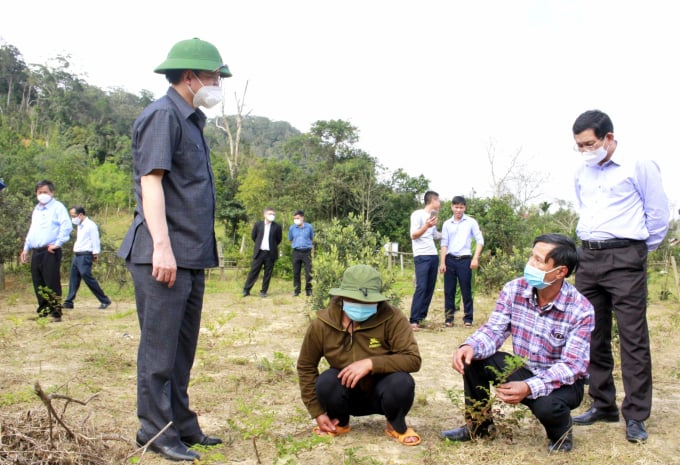November 28, 2025 | 03:33 GMT +7
November 28, 2025 | 03:33 GMT +7
Hotline: 0913.378.918
November 28, 2025 | 03:33 GMT +7
Hotline: 0913.378.918
I once had the opportunity to visit the herb growing area of Binh Dinh Pharmaceutical and Medical Equipment Company (BIDIPHAR) in village 3, An Toan commune (An Lao district, Binh Dinh) before the 2022 Lunar New Year.
I could not hide my surprise. In the “Good Agriculture Practice standard” area where vine tea was grown as recommended by the World Health Organization (GACP-WHO), I see vines laying bare on the ground, only the "skeleton" remains.
"Did this place really become a dead land?", I blurted out a question. Mr. Bui Ngoc Han, technical officer of Clean Herbal Medicines Project Management Board, BIDIPHAR, laughed and said: “No, they are just ‘hibernating’. After Tet they will all be fresh and green again.”

Vine tea grown on An Toan highland (An Lao district, Binh Dinh) in winter all has its leaves discarded by the harsh frost. Photo: V.D.T.
Within my observation, not only the herb growing area but also the avocado trees planted around those areas are shriveled because the frost has killed all the leaves. Only pennywort growing on the edge of the medicinal plants was lush and alive. Mr. Han explained that during winter the tree suffers greatly from frost as it kills the leaves, but the roots still grow strong. And when spring pass, the tree would accumulate enough nutrients to recover.
According to BIDIPHAR’s assessment, the medicinal content in herbs in An Toan highland is 5-7% higher than those in normal pharmacopeia. Specialists said that the climate and natural conditions at An Toan help medicinal plants accumulate many active ingredients, which is a prerequisite for manufacturers to attain high-quality herbal medicines and foods.
The only disadvantage of the climate in An Toan is that there are several months of hoarfrost every year, which means that medicinal plants grown here reluctantly take a few more months of "hibernation", unable to grow.
Mr. Ho Quang Thach, an officer of Binh Dinh Agricultural Extension Center, Leader of the specialist team, said that the herb’s "hibernation" phenomenon is the condition for the medicinal substances in the plant to increase. The tree's growth period is lengthened due to the influence of the high amplitude difference between day and night time, thus making the herb more qualitative. And also for that reason herbs grown in An Toan highland are 5-7% higher compared to those in normal pharmacopeia.

Mr. Ho Quoc Dung, Secretary of Binh Dinh Provincial Party Committee (far left, standing), inspecting the vine tea growing area in An Toan commune. Photo: V.D.T.
Since initiating the herb growing technique transfer project to ethnic minorities in An Toan at the end of October 2020, BIDIPHAR has used 1 ha of vine tea grown long ago in its medicinal garden to propagate seedlings to supply to the local people. Pilot models have also been deployed right after with a total area of 2.1 ha.
According to Mr. Ho Quang Thach, vine tea growers do not have to invest anything. All the effort will be poured into taking care of the herb.
Growers do not need to apply chemical fertilizers to the vine tea in order to ensure the herb is clean, only using manure 2 times/year. That is for vine tea grown in upland area, while the vine tea grown under forest canopy is only fertilized with manure in the first year. There will be no need for manure from the second year onward because there is already a layer of decaying vegetation under the forest canopy as fertilizer.
“The standard procedure given by BIDIPHAR is that vine tea is grown on upland area with a density of 50cm. Herb under forest canopy will be sparser. The plant-to-plant distance should be at 60 - 80cm.
Vine tea grown on upland area or under forest canopy after 1 year can be harvested. At the harvest period, 1 ha of green tea will yield approximately 16-18 tons of fresh tea. The current price is VND 6,000 - 7,000/kg of fresh tea for every 1 ha of vine tea. Growers will gain an income of more than VND 100 million.
At the end of April 2023, the vine ea project will end, then it will be transferred to farmers for mass planting through the agricultural extension model. Each family only needs to grow 2,000m2 of vine tea to earn 30-40% more than they could in the past as BIDIPHAR is always ready to underwrite the final product," Mr. Ho Quang Thach said.
Translated by Samuel Pham

(VAN) According to Mr. Vo Minh Thanh, Director of the Tay Ninh Department of Agriculture and Environment, Resolution 57 has created a new development pathway for the locality, shifting from traditional toward modern agriculture.
/2025/11/26/4909-2-154329_878.jpg)
(VAN) Pearl grouper farming in HDPE cages not only delivers economic efficiency but also contributes to protecting the environment, creating jobs, and promoting marine-based experiential tourism.

(VAN) The model of making a living under the forest canopy through the agroforestry system in Van Son commune, Bac Ninh province, is expected to generate an annual income of approximately VND 30 million/ha.

(VAN) Many enterprises in Can Tho are harnessing natural energy and reducing greenhouse gas emissions in their production processes, thereby contributing to the promotion of a sustainable green transition.
/2025/11/24/3536-2-112800_176.jpg)
(VAN) Dong Nai now has tens of thousands of hectares of forests certified for sustainable management, and this area will continue to be expanded in the coming period.

(VAN) Vinh Ha hamlet (Dai Xuyen commune, Hanoi) is shifting away from small-scale farming as households adopt bioscurity into their breeder chicken models.

(VAN) Heavy rains make aquatic species more vulnerable to disease. Proactive water management and high-tech systems help farmers prevent outbreaks and protect yields.